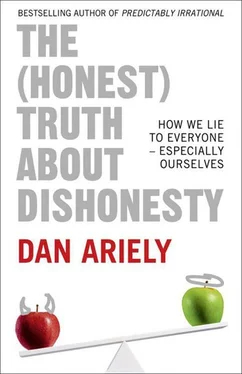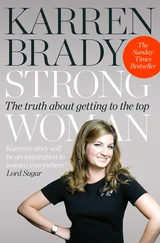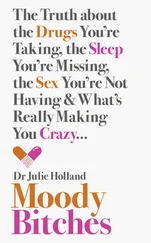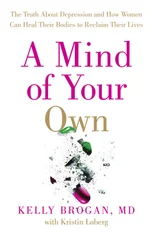Ariely, Dan - The (Honest) Truth About Dishonesty - How We Lie to Everyone – Especially Ourselves
Здесь есть возможность читать онлайн «Ariely, Dan - The (Honest) Truth About Dishonesty - How We Lie to Everyone – Especially Ourselves» весь текст электронной книги совершенно бесплатно (целиком полную версию без сокращений). В некоторых случаях можно слушать аудио, скачать через торрент в формате fb2 и присутствует краткое содержание. Жанр: Старинная литература, на английском языке. Описание произведения, (предисловие) а так же отзывы посетителей доступны на портале библиотеки ЛибКат.
- Название:The (Honest) Truth About Dishonesty: How We Lie to Everyone – Especially Ourselves
- Автор:
- Жанр:
- Год:неизвестен
- ISBN:нет данных
- Рейтинг книги:4 / 5. Голосов: 1
-
Избранное:Добавить в избранное
- Отзывы:
-
Ваша оценка:
- 80
- 1
- 2
- 3
- 4
- 5
The (Honest) Truth About Dishonesty: How We Lie to Everyone – Especially Ourselves: краткое содержание, описание и аннотация
Предлагаем к чтению аннотацию, описание, краткое содержание или предисловие (зависит от того, что написал сам автор книги «The (Honest) Truth About Dishonesty: How We Lie to Everyone – Especially Ourselves»). Если вы не нашли необходимую информацию о книге — напишите в комментариях, мы постараемся отыскать её.
The (Honest) Truth About Dishonesty: How We Lie to Everyone – Especially Ourselves — читать онлайн бесплатно полную книгу (весь текст) целиком
Ниже представлен текст книги, разбитый по страницам. Система сохранения места последней прочитанной страницы, позволяет с удобством читать онлайн бесплатно книгу «The (Honest) Truth About Dishonesty: How We Lie to Everyone – Especially Ourselves», без необходимости каждый раз заново искать на чём Вы остановились. Поставьте закладку, и сможете в любой момент перейти на страницу, на которой закончили чтение.
Интервал:
Закладка:
Understanding depletion also means that (to the extent that we can) we should face the situations that require self-control—a particularly tedious assignment at work, for example—early in the day, before we are too depleted. This, of course, is not easy advice to follow because the commercial forces around us (bars, online shopping, Facebook, YouTube, online computer games, and so on) thrive on both temptation and depletion, which is why they are so successful.
Granted, we cannot avoid being exposed to all threats to our self-control. So is there any hope for us? Here’s one suggestion: once we realize that it is very hard to turn away when we face temptation, we can recognize that a better strategy is to walk away from the draw of desire before we are close enough to be snagged by it. Accepting this advice might not be easy, but the reality is that it is much easier to avoid temptation altogether rather than to overcome it when it sits lingering on the kitchen counter. And if we can’t quite do that, we can always try to work on our ability to fight temptation—perhaps by counting to a hundred, singing a song, or making an action plan and sticking to it. Doing any of these can help us build our arsenal of tricks for overcoming temptation so that we are better equipped to fight those urges in the future.
FINALLY, I SHOULDpoint out that sometimes depletion can be beneficial. Occasionally, we may feel that we are too much in control, dealing with too many restrictions, and that we’re not sufficiently free to follow our impulses. Perhaps sometimes, we just need to stop being responsible adults and let loose. So here’s a tip: next time you really want to let it all hang out and indulge your primal self, try depleting yourself first by writing a long autobiographical essay without using the letters “a” and “n.” Then go to a mall, try on different things, but buy nothing. Afterward, with all of this depletion weighing on you, place yourself in the tempting situation of your choice and let ’er rip. Just don’t use this trick too often.
AND IF YOUreally need a more official-sounding excuse to succumb to temptation from time to time, just use Dan Silverman’s theory of rational self-indulgence as the ultimate license.
CHAPTER 5
Why Wearing Fakes Makes Us Cheat More
Let me tell you the story of my debut into the world of fashion. When Jennifer Wideman Green (a friend of mine from graduate school) ended up living in New York City, she met a number of people in the fashion industry. Through her I met Freeda Fawal-Farah, who worked for Harper’s Bazaar , a gold standard in the fashion industry. A few months later Freeda invited me to give a talk at the magazine, and because it was such an atypical crowd for me, I agreed.
Before I started my talk, Freeda treated me to a quick fashion tutorial as we sipped our lattes in a balcony café overlooking the escalator in the big downtown Manhattan building. Freeda gave me a rundown of the outfits worn by every woman who passed us, including the brands they were wearing and what her clothes and shoes said about her lifestyle. I found her attention to every detail—indeed, the whole fashion analysis—fascinating, the way I imagine expert bird watchers are able to discern minute differences between species.
About thirty minutes later, I found myself on a stage before an auditorium full of fashion mavens. It was a tremendous pleasure to be surrounded by so many attractive and well-dressed women. Each woman was like an exhibit in a museum: her jewelry, her makeup, and, of course, her stunning shoes. Thanks to Freeda’s tutorial, I was able to recognize a few of the brands when I looked out into the rows. I could even discern the sense of fashion that inspired each ensemble.
I wasn’t sure why those fashionistas wanted me there or what they expected to hear from me. Still, we seemed to have good chemistry. I talked about how people make decisions, how we compare prices when we are trying to figure out how much something is worth, how we compare ourselves to others, and so on. They laughed when I hoped they would, asked thoughtful questions, and offered plenty of their own interesting ideas. When I finished the talk, Valerie Salembier, the publisher of Harper’s Bazaar , came onstage, hugged and thanked me—and gave me a stylish black Prada overnight bag.
AFTER SAYING OURgood-byes, I left the building with my new Prada bag and headed downtown to my next meeting. I had some time to kill, so I decided to take a walk. As I wandered, I couldn’t help thinking about my big black leather bag with its large Prada logo displayed. I debated with myself: should I carry my new bag with the logo facing outward? That way, other people could see and admire it (or maybe just wonder how someone wearing jeans and red sneakers could possibly have procured it). Or should I carry it with the logo facing toward me, so that no one could recognize that it was a Prada? I decided on the latter and turned the bag around.
Even though I was pretty sure that with the logo hidden no one realized it was a Prada bag, and despite the fact that I don’t think of myself as someone who cares about fashion, something felt different to me. I was continuously aware of the brand on the bag. I was wearing Prada! And it made me feel different; I stood a little straighter and walked with a bit more swagger. I wondered what would happen if I wore Ferrari underwear. Would I feel more invigorated? More confident? More agile? Faster?
I continued walking and passed through Chinatown, which was bustling with activity, food, smells, and street vendors selling their wares along Canal Street. Not far away, I spotted an attractive young couple in their twenties taking in the scene. A Chinese man approached them. “Handbags, handbags!” he called, tilting his head to indicate the direction of his small shop. At first they didn’t react. Then, after a moment or two, the woman asked the Chinese man, “You have Prada?”
The vendor nodded. I watched as she conferred with her partner. He smiled at her, and they followed the man to his stand.
The Prada they were referring to, of course, was not actually Prada. Nor were the $5 “designer” sunglasses on display in his stand really Dolce&Gabbana. And the Armani perfumes displayed over by the street food stands? Fakes too. *
From Ermine to Armani
Let’s pause for a moment and consider the history of wardrobes, thinking specifically about something social scientists call external signaling, which is simply the way we broadcast to others who we are by what we wear. Going back a way, ancient Roman law included a set of regulations called sumptuary laws, which filtered down through the centuries into the laws of nearly all European nations. Among other things, the laws dictated who could wear what, according to their station and class. The laws went into an extraordinary level of detail. For example, in Renaissance England, only the nobility could wear certain kinds of fur, fabrics, laces, decorative beading per square foot, and so on, while those in the gentry could wear decisively less appealing clothing. (The poorest were generally excluded from the law, as there was little point in regulating musty burlap, wool, and hair shirts.)
Some groups were further differentiated so as not to be confused with “respectable” people. For instance, prostitutes had to wear striped hoods to signal their “impurity,” and heretics were sometimes forced to don patches decorated with wood bundles to indicate that they could or should be burned at the stake. In a sense, a prostitute going out without her mandatory striped hood was in disguise, like someone wearing a pair of fake Gucci sunglasses. A solid, nonstriped hood sent a false signal of the woman’s livelihood and economic status. People who “dressed above their station” were silently, but directly, lying to those around them. Although dressing above one’s station was not a capital offense, those who broke the law were often hit with fines and other punishments.
Читать дальшеИнтервал:
Закладка:
Похожие книги на «The (Honest) Truth About Dishonesty: How We Lie to Everyone – Especially Ourselves»
Представляем Вашему вниманию похожие книги на «The (Honest) Truth About Dishonesty: How We Lie to Everyone – Especially Ourselves» списком для выбора. Мы отобрали схожую по названию и смыслу литературу в надежде предоставить читателям больше вариантов отыскать новые, интересные, ещё непрочитанные произведения.
Обсуждение, отзывы о книге «The (Honest) Truth About Dishonesty: How We Lie to Everyone – Especially Ourselves» и просто собственные мнения читателей. Оставьте ваши комментарии, напишите, что Вы думаете о произведении, его смысле или главных героях. Укажите что конкретно понравилось, а что нет, и почему Вы так считаете.












